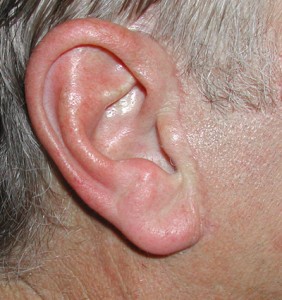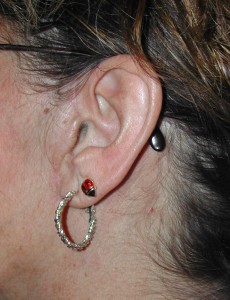Incision planning and execution is one of the most overlooked aspects of facelift surgery. While patients may get caught up in the details of whether and how the SMAS is manipulated, for example, facelift incisions actually are more crucial to a successful outcome and the long term satisfaction from a facelift. Visible scars or changes to the hairline are the most frequent source of patient dissatisfaction which can mar an otherwise good facelift result. An unaltered hairline that permits patients to have the freedom to wear their hairstyle as they choose and near invisble often separates the good from the ‘bad’ facelift result.
There are three key techniques in planning facelift incisions. These include anterior hairline management (preauricular tuft of hair and sideburn) and preauricular and postauricular incision placement.
Every patient, both female and male, has a different width and location of the lower end of the sideburn (in females it is called the preauricular tuft) as it extends downard of the superior attachment of the helix of the ear. For a low sitting sideburn (1 to 2 cms below the ear), the preauricular incision can extend upward in a curved design into the temporal hairline. This will allow for some slight upward and backward translocation of the hairline but not excessively so. As long as the hairline is lifted no higher than the level of the attachment of the ear, it will still look natural. The curved temporal portion of the incision will resist scar contracture and an obvious line of alopecia.
If the sideburn is naturally at the level of the ear, then the incision must be made along the bottom edge of the hairline. This will allow the cheek and lateral facial tissues to be lift without changing the sideburn location. This is what is referred to as a hairine blocking incision.

On the back of the ear, the postauricular incision should be placed a few millimeters onto the back of the ear so that the final scar line will settle into the actual sulcus and not outward onto the mastoid skin. At some point the incision must move away from the back of the ear towards and into the postauricular hairline for any significant neck skin translocation to occur. This is best done at the level of the tragus as the distance from the postauricular hairline and the shadow of the back of the ear gets closer at this point. Many facelift patients do not need an extended incision into or along the postauricular hairline unless there is a large amount of neck that needs to be moved back. In these cases the incision is carried back back into the postauricular hair rather than following the hairline down into the anterior neck.
Proper incision placement, while not the only important part of a facelift, makes the operation look natural with good scar camouflage and unaltered hairlines.
Dr. Barry Eppley
Indianapolis, Indiana



